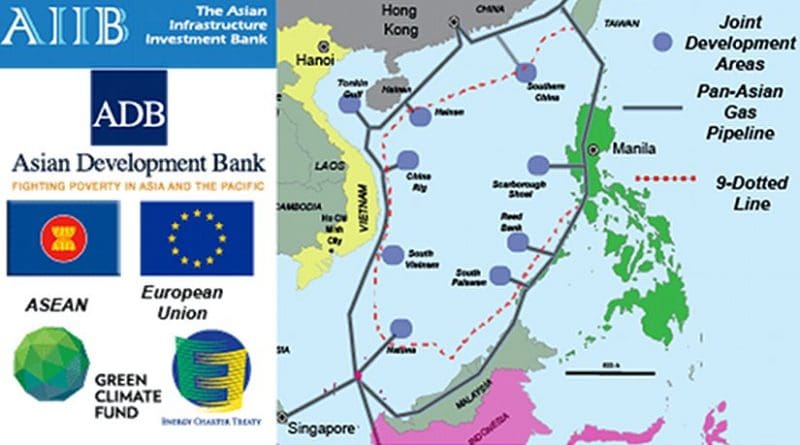China’s Asian Infrastructure Bank: South China Sea Mediator? – Analysis
Can the Asian Infrastructure Investment Bank (AIIB) provide a forum for territorial compromise in the South China Sea?
The AIIB’s Articles of Agreement takes pains to lay out the bank’s non-political, economic-only nature. This commitment will be put to the test as the AIIB chooses projects to fund.
Since its creation six months ago, the AIIB has approved funding only for two small roadway projects in the authoritarian states of Tajikistan and Kazakhstan.
Given this, doubts remain regarding the AIIB’s professed independence from China’s Communist Party leadership.
In the future, the AIIB must start approving loans to more open, pluralistic democracies with more open, active civil societies — like Southeast Asia. It’s here where the AIIB’s mettle will be tested.
To demonstrate true AIIB political independence from China’s Communist Party, two projects stand out. The AIIB should fund both.
The two are the Trans-ASEAN Gas Pipeline (TAGP) and Trans-ASEAN Electricity Grid (TAEG). The two projects will more deeply integrate the energy economies of Association of Southeast Asian Nations’ 10 members.
They would do this through increasing cross-border natural gas pipeline and electricity interconnections. Six of ASEAN’s 10 members have South China Sea coastlines. Two others have coastlines on the Gulf of Thailand.
The combined cost of the TAGP and TAEG is around $13 billion — a big sum for the AIIB to lend in its first year.
But the economic merit of these two projects and their potential for reducing political tension in the South China Sea make them special.
One way to fund them would be for the AIIB and other multilateral lenders — like the Asian Development Bank, World Bank, Green Climate Fund (and others) to work together in providing the money.
In addition to spreading loan-repayment risk, such cooperation could help encourage creation of common regional technical standards of interconnection.
This would help reduce destructive climate change through making future energy markets more competitive by encouraging greater energy substitution.
Substitution will become increasingly important as carbon pricing spreads. It will allow dynamic relative pricing to alter consumption habits and influence future investments — creating positively-reinforcing cycle.
In coming years, the world must spend up to US$100 trillion building infrastructure and reducing carbon emissions. This spending will largely determine what life is like for humanity later in the century.
Over the short term, funding the TAGP and TAEG may hinge in part upon China and Southeast Asia reaching political accommodation over disputed areas in the South China Sea.
This accommodation can be reached by by China and her ASEAN neighbors agreeing to create joint development areas that could utilize the infrastructure of the TAGP and TAEG.
This would solve two problems at once: territorial issues and securing reliable future energy supplies. That’s because bits of both the TAGP and TAEG would traverse contested parts of the South China Sea.
So, where to now with this?
In coming weeks, a UN tribunal in the Netherlands is expected to reject the legitimacy of China’s Nine-Dotted Line in which China has laid claim to virtually the entire South China Sea. China is politically isolated on this issue and has painted itself in a corner by saying it will ignore any UN decision that goes against it.
If China holds to that line, it will destroy confidence in the newly-created AIIB. Unfortunately, Chinese domestic propaganda has done little to prepare China’s citizenry for compromise.
Therefore, agreeing to South China Sea joint development areas which postpone territorial finality while enabling economic-growth and employment generating infrastructure investment looks like the best compromise available.
China would benefit as much as anyone. The country has amassed an increasingly destabilizing multi-trillion US dollar cash hoard created by maintaining an artificially weak yuan. This money needs to be recycled back into the world economy.
China has world-class companies capable of building roads, rail systems, power lines and other key infrastructure. These companies are huge domestic employers of Chinese labor. Without new projects these companies may have to engage in politically-destabilizing layoffs.
Viewed, this way, it’s not hard to see AIIB overseas investment as a necessity for China’s domestic macroeconomic management as much as it is a ‘coming out’ gift of a beneficent new world power.
In other words, China needs to build international infrastructure projects as much as the rest of the world needs to have them built. This symbiosis alone should ensure cooler heads prevail.
For the AIIB, infrastructure investments in Southeast Asia connecting offshore joint development areas offer the institution the opportunity to end doubts regarding its independence, probity and governance.
The AIIB, of course, would do this through playing a leading role funding an unparalleled opportunity to calm perhaps the world’s most worrisome trouble spot: the South China Sea.
A bundle of benefits now await Asia. The ball’s in the court of the region’s statesmen. Everyone has reason to hope and prey they see the benefits.

